Earlier this year, we predicted Democratization of AI and Low-Code / No-Code solutions would become one of the top technology trends in 2021 that business leaders should keep an eye on. In our recent post, Intelligent Edge AI Video Analytics, we shared evidence and key indicators that that prediction was ringing true with Artificial Intelligence (AI) is on the rise and disrupting almost every aspect of our lives. In this post we’ll continue our #SummerofAI theme and take a deeper look at the democratization of AI and how modern AI tools are enabling anyone to become a citizen data scientist. Including market research data, an overview of possible solutions, and a real-world example with our own workplace safety Edge AI model, built with Lobe.ai.
The Growth of Low-Code AI Solutions Analysts from research companies like Gartner describe the democratization of AI in various flavors but all with a transformational character, which is Gartner’s highest benefit rating. For example, citizen data science in which a domain expert can leverage easy-to-use data science tools without prior data science knowledge. This is extremely useful as a true domain experts with years of experience and domain expertise can create valuable AI solutions at a speed rivaling that of any data scientist having to learn the domain. All without the steep learning curve of data science. This preexisting expertise not only increases the viability, speed to market and ROI of the resulting solution, but also allows organizations to leverage rare data scientist resources on more complex problems like optimizing models.
Other areas of increasing popularity is AI-Augmented Design where AI tools help to automatically create or enhance visual design, storyboards, user flows and presentation layer code. Also, AI-Augmented Development where Machine Learning and AI technologies in general are used to enhance application development to deliver software faster, more consistently, and with higher quality. This is also particularly interesting for low-code development where a co-pilot AI assistant can even help to complete code snippets.
The demand for developers and other technology-related jobs, in particular in the field of AI and data science, is continuing to grow. LinkedIn’s emerging job report is stating that no less than 150 million technology-related jobs will be added globally over the next 5 years. The US Emerging Jobs Report 2020 also estimates a 35% annual growth for data scientist and data engineer roles. And recent data is indicating that the demand is growing even further. With this rate of increase, it will be hard to find enough specialists with the necessary skillsets to fill the demand. Low-code and no-code AI tools provide organizations the opportunity to close the gap with the help of citizen data scientist that won’t need an AI expert to build custom AI solutions for many scenarios.
Business leaders should stay on top of these trends and encourage their domain-experts, design, and development teams to evaluate and adapt various AI tools to enhance their abilities and optimize their workflows. Leaders should also develop a plan for educating their workforce about responsible usage of these tools and the ethical implications of biased data for example. We will share more about this important topic in an upcoming #SummerofAI post on ethical and responsible AI usage.

Figure 1: Gartner Emerging Technologies Trend Impact Radar with Low-Code Application Platforms at the center of maturity (Source: https://blogs.gartner.com/tuong-nguyen/2020/12/07/gartner-launches-emerging-technologies-radar-2021)
Microsoft’s Low-Code and No-Code AI solutionsLike most large tech companies, Microsoft is also investing heavily into the field of citizen developers, citizen data scientists. Their Business Application Platform offers a variety of compelling solutions ranging from no-code or low-code to full-code development.
Microsoft PowerPoint: AI-Augmented design for example is already integrated in a couple of Office 365 products like the AI-powered PowerPoint Designer. This feature makes recommendations for slide layouts and helps to quickly turn a boring deck into a nicely designed one. It can provide fully themed decks or just suggestions for certain improvements like better text readability. For accessibility users can take advantage of automatic alt-text, subtitles and live captioning during presentations. This means AI is fully integrated in PowerPoint and helps at all stages of a presentation. Including presentation rehearsal, with a virtual Presenter Coach providing guidance. You can learn more about these features here.
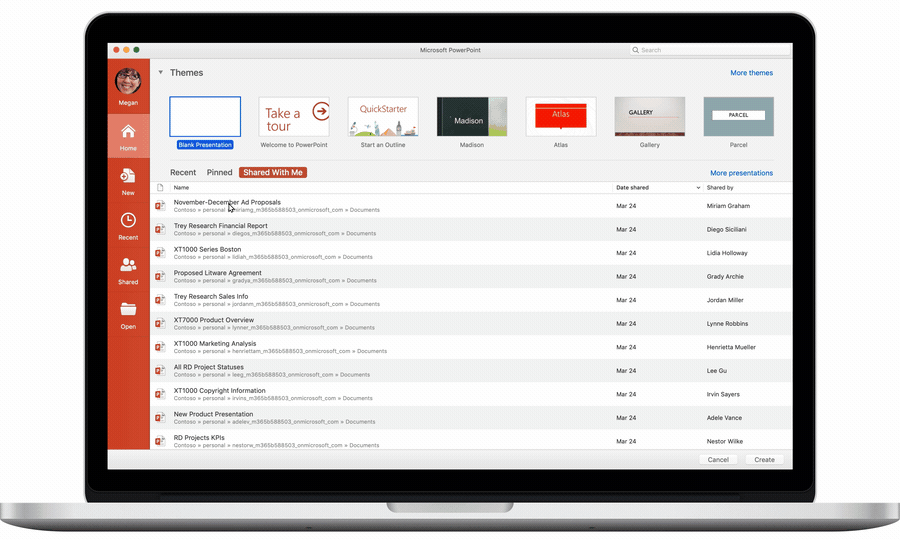
Figure 2: PowerPoint's AI Designer in-action providing automatic layout suggestions. (Source : https://news.microsoft.com/en-in/4-ways-ai-in-powerpoint-will-help-you-nail-your-next-presentation)
Microsoft Word: AI-Augmented writing is also already integrated into Office 365 like Microsoft Word providing an AI-powered auto-complete feature with text predictions. In fact, this text you are reading right now was written with the help of Word’s Text Predictions. As you can see below, this feature is not like other AI experiments where it would complete a whole text document from a short paragraph. Rather it is providing suggestions for upcoming word groups to speed typing. Word also features AI tools to make text more accessible with semi-automatic alt-text generation and accessibility checker.
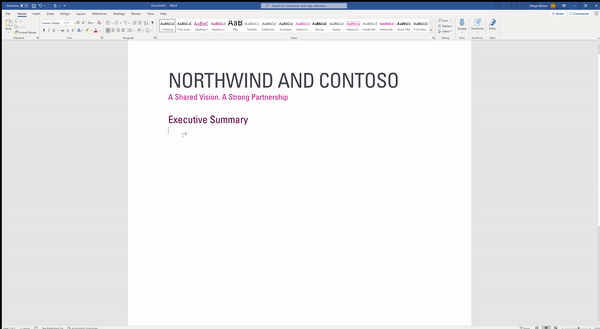
Figure 3: Word's AI Text Prediction in-action suggesting contextual completion. (Source: https://insider.office.com/en-us/blog/text-predictions-in-word-outlook?WT.mc_id=MR-MVP-4028386)
GitHub: AI-Augmented Development was recently introduced by the Microsoft owned open-source community, GitHub. GitHub’s Co-Pilot aIt text completion goes farther than the average text completion to provide suggestions for code lines or even entire functions and methods right inside the Visual Studio Code editor. Co-Pilot leverages the new Codex AI system from OpenAI, which was trained on billions of lines of code from GitHub’s public source code repositories and its diverse set of programing languages. Co-Pilot is currently in a private preview program but is already looking quite promising for making the life of developers easier with automation for mundane tasks.

Figure 4: GitHub Co-Pilot in-action completing programming code with AI predictions. (Source: https://venturebeat.com/2021/06/29/github-launches-copilot-to-power-pair-programming-with-ai/)
Azure Cognitive Services: Beside AI becoming a great pair-programmer with GitHub Co-Pilot, there are also services for developers to easily add AI intelligence to their apps. Azure Cognitive Services for example, offers a wide range of services that bring AI within the reach of every developer without any prior machine learning expertise. Cognitive Services allows users to embed the ability to see, hear, speak, search, understand, and accelerate decision-making into any apps via simple REST API calls or specialized SDKs. Cognitive Services leverages pre-trained AI models that can even be customized to specific needs like Custom Vision to create custom AI computer vision solutions. Many of the Cognitive Services are also available on the edge and can run workloads on-site at edge devices.
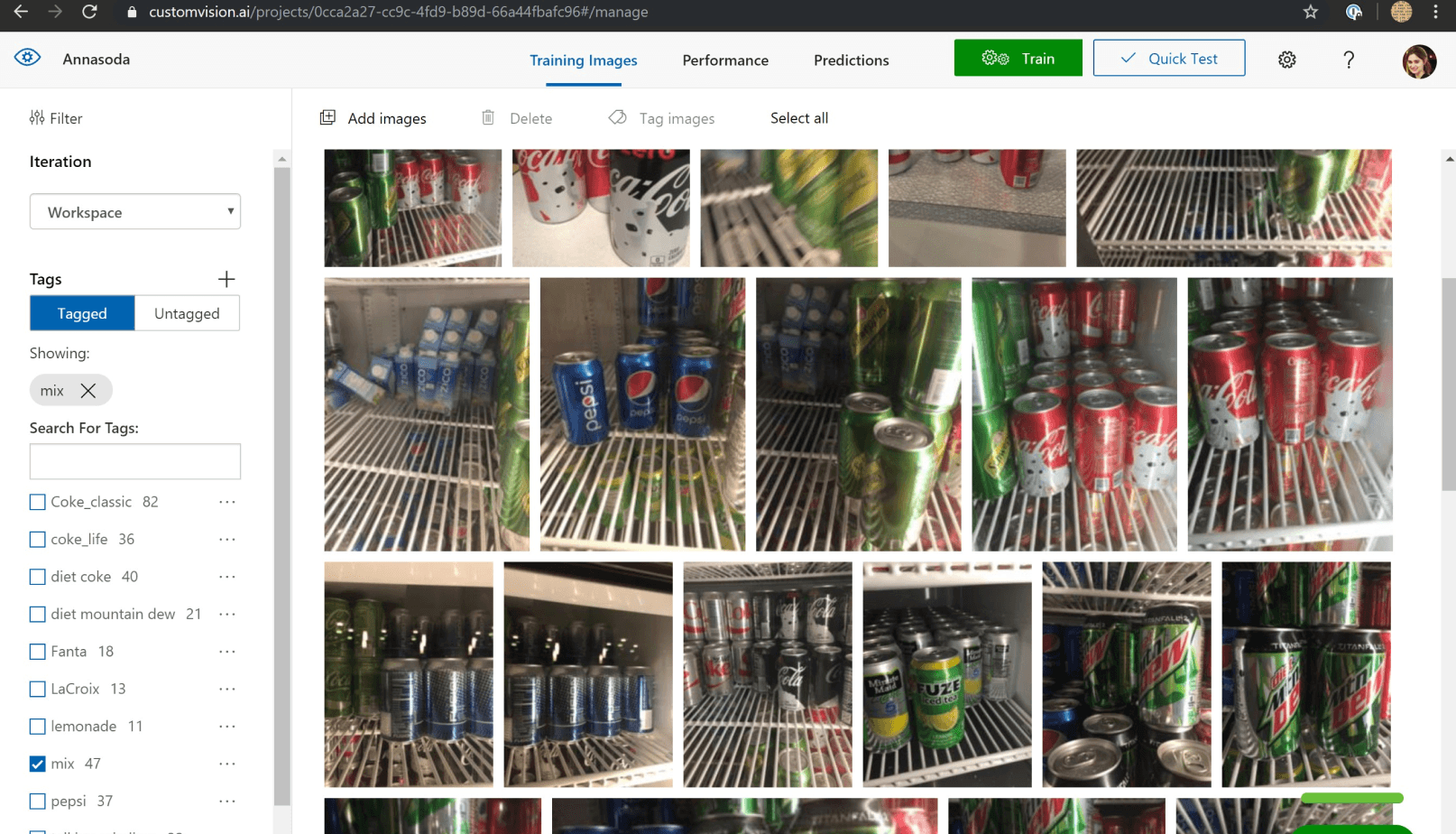
Figure 5: Custom Vision's web UI for creating customized classification models form a selection of labelled photos. (Source: https://azure.microsoft.com/en-us/services/cognitive-services/custom-vision-service)
Azure Machine Learning Studio is another great tool in the Microsoft belt to build AI models without writing any line of code. Azure ML Studio supports a wide range of diversely skilled users, combining no-code and code-first experiences in an inclusive data science platform. It even features AutoML, a technique that will automatically decide what the best Machine Learning model architecture is for a given problem statement and data domain.
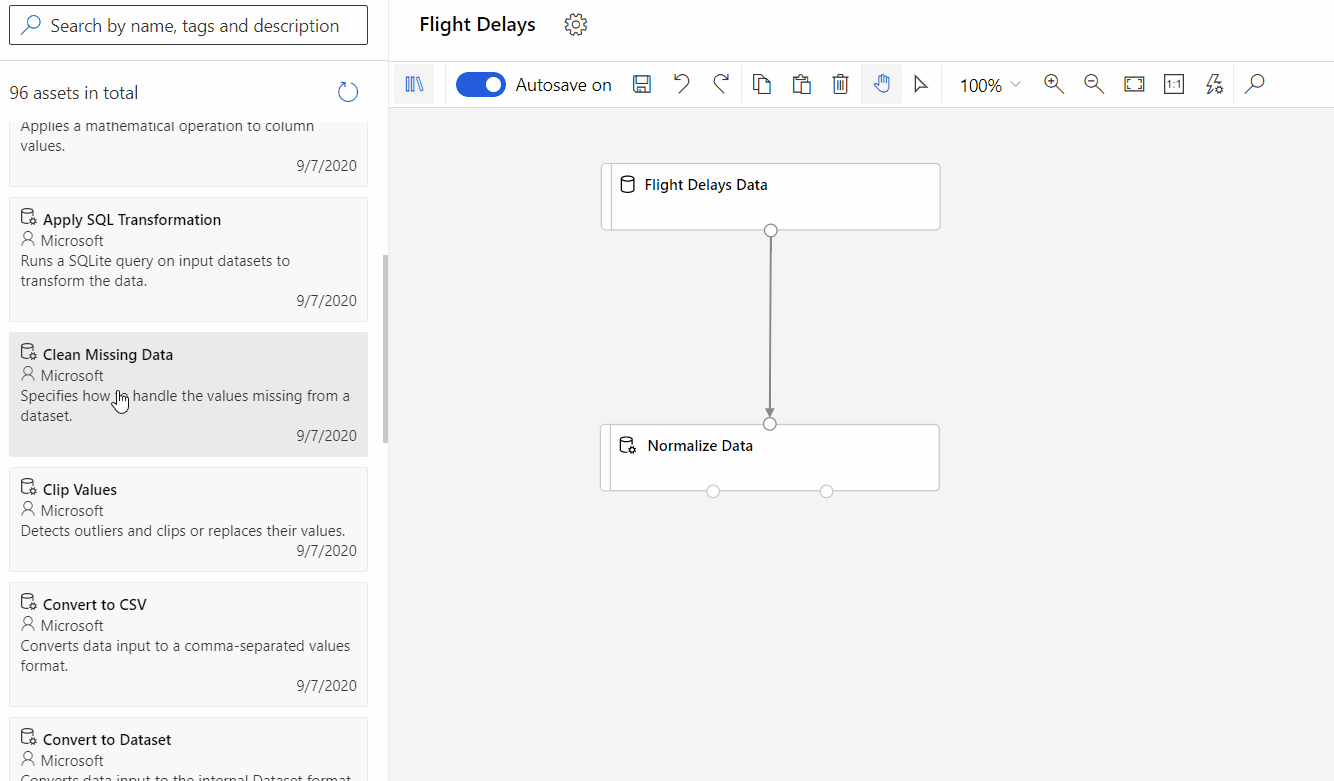
Figure 6: The Azure ML Designer in-action with drag and drop functionality to create ML pipelines without writing any code. (Source: https://docs.microsoft.com/en-us/azure/machine-learning/overview-what-is-machine-learning-studio)
Azure Machine Learning MLOps: Another nice feature of Azure Machine Learning is the handling of the DevOps cycle with built-in Machine Learning Operations. MLOps increases the efficiency of handling AI models for faster development, deployment, and quality assurance life cycles. MLOps is not to be confused with AIOps which uses artificial intelligence to simplify IT operations management by automatically resolving problems and improving insights. As the age of cloud computing continues, enterprise customers are rarely running their workloads on-premises. Instead opting for the cloud with all its benefits. One small downside is that the actual hardware is not seen anymore. Therefore insights, troubleshooting, etc. becomes an abstract process. Gone are the days of the IT admin going to the server room and pulling a network cable or running similar try & error troubleshooting. Also, the vast amount of telemetry and application insight analytics data being gathered is hard for humans to digest on their own. This is where AIOps can help and Microsoft is investing a lot in this area. Azure already has a few things built-in like the Azure Monitor AIOps alerts with Dynamic Threshold where the threshold does not have to be set and adapted manually in a time consuming way. Instead, the threshold is set automatically with Machine Learning based on historical behavior. In general, AIOps will make the analytics data, which is often not leveraged at all or only used in a reactive manner to troubleshoot issues, more useful. AIOps provides the opportunity to leverage the analytics data in a proactive manner for predictive intelligence with Machine Learning and can automatically identify upcoming problems. If done correctly changes and adjustments can be made automatically before the issue occurs to increase uptime and quality of service. Therefore, AIOps has the potential to provide predictive maintenance for cloud computing without having to write any line of code.

Figure 7: Microsoft’s AIOps methodologies: Data, insights, and actions. (Source: https://azure.microsoft.com/en-us/blog/advancing-azure-service-quality-with-artificial-intelligence-aiops)
Microsoft Power Platform: Microsoft’s low-code/no-code (LC/NC) Power Platform allows you to easily create custom applications, even for non-developers and also supports infusing AI to create intelligent apps like chatbot virtual agents and automation tools. Recently at the Build developer conference Microsoft unveiled a new exciting Power Platform addition leveraging one of the world’s largest, language transformer models – OpenAI’s GPT-3. For Power Apps it is being used for various things like turning natural language into Power Fx formulas (the low-code mechanism used in Power Apps). So, kind of AI-Augmented Development for the low-code creation of custom apps. Additionally, it also supports programing by example and will turn an example into AI-generated code output. All of that is directly integrated into Power Apps Studio to support every user to quickly build apps while also learning advanced concepts during the process.
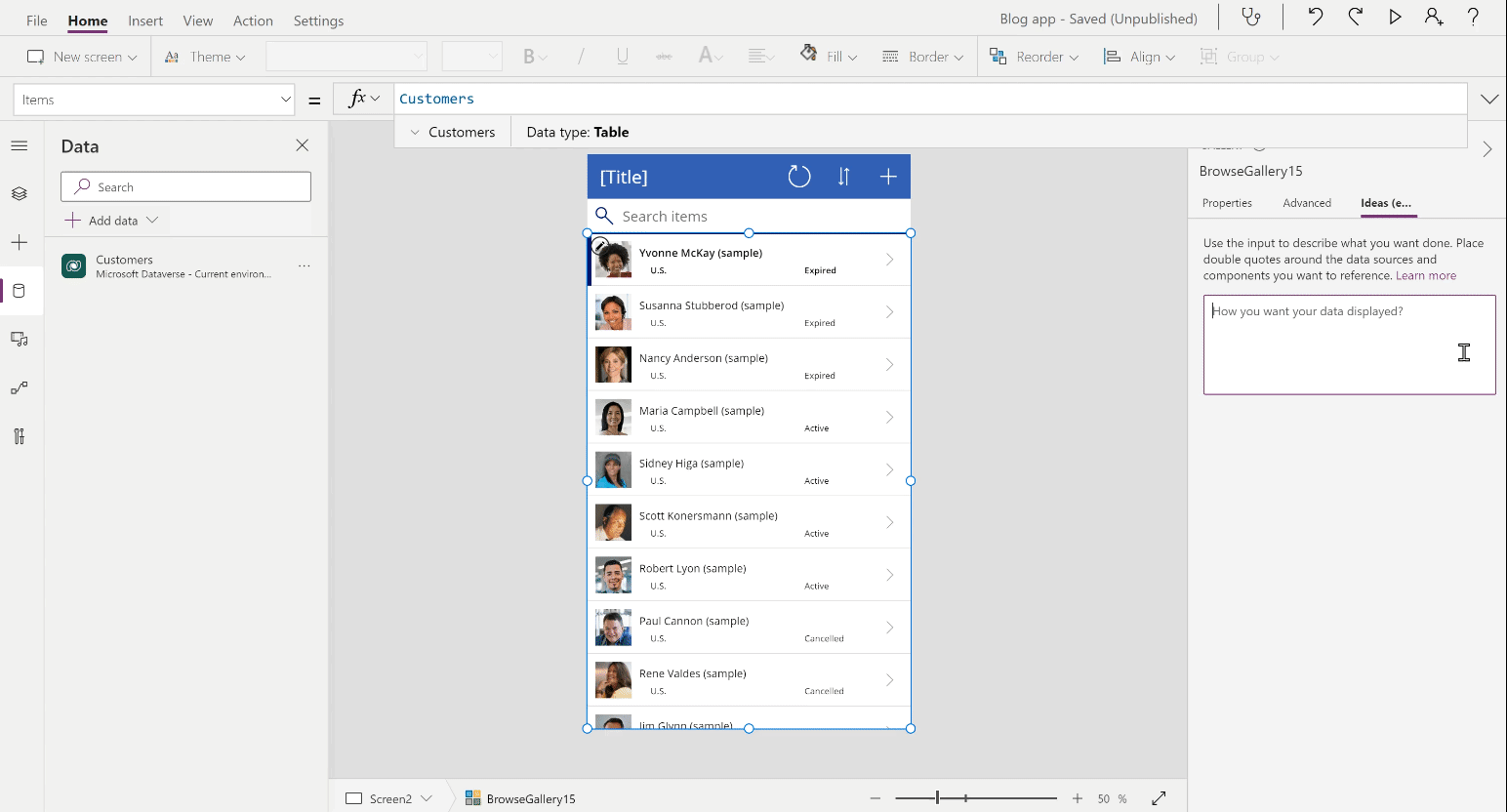
Figure 8: Power Apps natural language turned into Power FX scripting formulas by the AI. (Source: https://powerapps.microsoft.com/en-us/blog/introducing-power-apps-ideas-ai-powered-assistance-now-helps-anyone-create-apps-using-natural-language)
Power BI is another very powerful part of the Microsoft Power Platform providing data-driven insights. Valorem Reply’s Data & AI Team has deep Power BI expertise and regularly provide free training opportunities like Analytics in a Day Workshops, Dashboard in a Day Workshops, and our new all-inclusive Power Platform in a Day Workshops. You can sign-up for one of our free events here or even request a private workshop for just your team here and here. In addition, Valorem Reply can provide Power BI and Power Platform expertise in a Managed Service model, allowing organizations to experience the power of these tools without the required technical expertise at all or as an interim solution while their internal team comes up to speed.
Azure Percept: In our previous article in the Summer of AI series we covered Edge AI Video Analytics and mentioned Microsoft’s new end-to-end intelligent edge solution called Azure Percept. It comes in the form of Azure services, tooling and a development kit called Azure Percept DK with a range of pre-built AI models. However, it is also possible to build custom models with no-code, nicely streamlined with the Azure Percept Studio application. Including the semi-automatic generation of Deep Learning training data with automatically triggered camera captures. You can learn more details about Azure Percept in my Ignite 2021 recap video here.
Lobe.ai: Microsoft has a diverse portfolio and offers multiple solutions for various scenarios. In the case of no-code AI model creation, there is also Lobe.ai which Microsoft acquired in 2018. Lobe is aiming to truly democratize Machine Learning with an easy-to-use desktop application available for free as public preview for Windows or Mac computers. Lobe leverages open-source AI model architectures and transfer learning to train custom machine learning models on the user’s own machine. This means all the data is kept locally and no internet connection nor login is required.
Low-Code Workplace Safety Edge AI with LobeLobe can be used to create various solutions for an AI computer vision task called image classification. This is what I used in our earlier post as part of the Summer of AI series, where we introduced a custom Edge AI standalone solution for a workplace safety scenario leveraging video analytics.

Figure 9: Our workplace safety demo running on an advanced Raspberry Pi 4 Adafruit ML Kit, executing a safety glasses detection AI model created with Lobe.
The Adafruit ML Kit for Lobe allows you to quickly create custom low-cost Edge AI solutions that directly run on a Raspberry Pi 4. In combination with Microsoft’s low-code AI platform Lobe.ai, custom AI vision models can be created and deployed on the Raspberry Pi for a quick and iterative approach to Edge AI development.
The AI model running on the edge in our solution is a custom Lobe image classifier that can detect if the person in front of the camera is wearing “Safety Glasses” or “No Glasses”. There is also a 3rd classification class called “Glasses” which is for normal prescription glasses. I did this to challenge the Lobe.ai Deep Learning model as it is quite hard to distinguish between normal and safety glasses, even for human vision. I trained the model with over 200 images for each of the 3 classes under various light conditions and sceneries also while I was wearing different outfits. The result is a 99% accuracy on the 658 images used for training and testing of this computer vision model. I also tested it under real-world conditions with other people and the AI model generalized well enough to distinguish between safety and normal glasses on other subjects besides me, which is quite impressive.
Using over 600 manually labeled images for training a model sounds like quite an effort but in fact it was not that time intensive. Lobe does not just allow the import of images but can use a webcam to quickly capture photos and assign a label. Lobe’s great UX (user experience) and UI (user interface) make that task very easy and efficient with real-time feedback for the evaluation and fine-tuning.

Figure 10: The Lobe app in-action with my Safety Glasses Detector project showing a set of training images with a range of variations to have a better generalized AI model.
Lobe allows basically anyone, regardless of prior data science experience, to import images and easily label them for creating a Deep Learning dataset. Lobe will automatically select the right AI model architecture and start training in the background without any setup or configuration. Once training is done, users can evaluate the model accuracy with real-time visual feedback. Then experiment with the customized model and enhance performance by providing real-time feedback on the evaluation results. The finished models can then be exported to various industry standard formats and embedded in apps, websites, or Edge IoT devices like I did with the Raspberry Pi Adafruit ML Kit for our workplace safety solution.
As this article shows, the demand for intelligent solutions requiring specialized skills is growing further but there is a lack of supply. Fortunately, there are a wide range of options on the market that democratize AI with low-code and no-code development which empower everyone to create intelligent solutions customized for their domain specific needs. Navigating available options and choosing the best approach for your need is not easy, but we are here to help! If you are ready to build your own customized AI solutions with us or want to learn more, Valorem Reply’s Data & AI team can help you to reach your goals quickly and efficiently. Reach out to us as marketing@valorem.com to schedule time with one of our industry experts.
